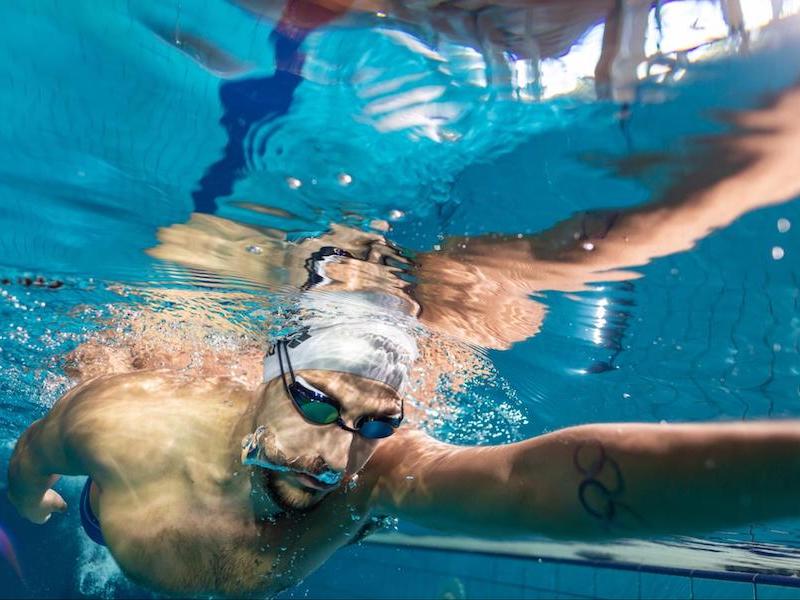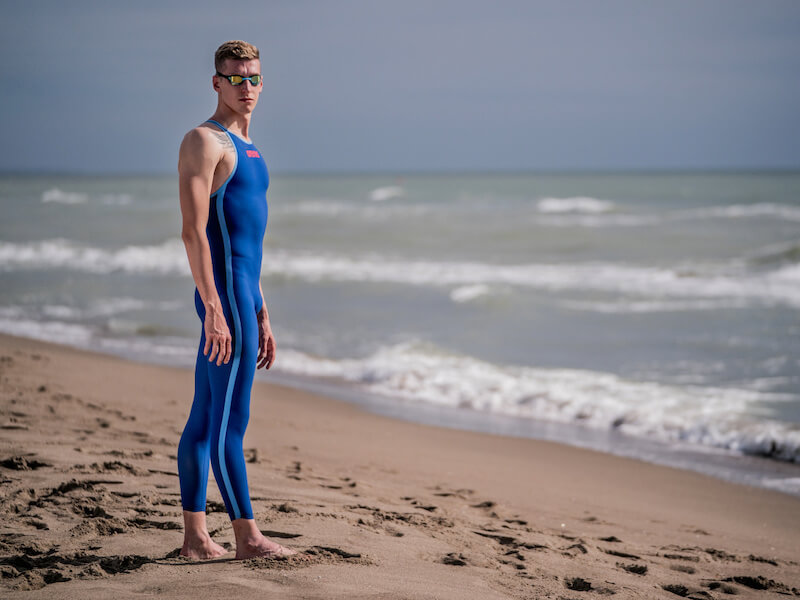Train to Go the Distance: Long-Distance Swim Workouts
Long-distance swimming is a rewarding challenge for both the body and mind. Distance training often requires long hours of keeping your head down and bearing through a long-distance swim workout, but the physical and mental benefits of endurance swimming are well worth the hard work.
Whether you’re looking to be a competitive swimmer in 800m or 1500m freestyle swim races or you’ll be competing in open-water events, this article will provide you with a handful of great long-distance swim workouts and crucial information about what your body needs so you can complete the exercises safely and effectively.
Work Your Way Up to Long-Distance Swims
Allow yourself the appropriate amount of time to build up your fitness level to swim long distances. Especially if you are new to the sport of swimming, it is a good idea to create a training plan that gives your body the time to become accustomed to the exercise you are putting it up against. Here are some of the major reasons you should pace yourself as you train to become a distance swimmer:
- Safety: Long-distance swim workouts call for prolonged amounts of time spent in the water. If you become overtired in the middle of a swim, especially if you’re training in open water, you could find yourself in a dangerous situation. It’s better to be safe and increase distance gradually.
- Avoid burnout: Endurance swimming is a challenge for the mind and the body. If you overextend your abilities initially, you run the risk of becoming burnt out on the sport. Challenge your body and mind just enough to keep improving but not so much that you want to quit after a few months.
- Better results: You’ll likely see better results if you pace yourself. You’re less likely to sustain an injury from overtraining, and your body will feel stronger and more capable when you pace your progress appropriately.
How to Take Care of Your Body When Training for Endurance Swimming

Like other endurance sports, long-distance swimming is a challenge for the body, and it needs your help to stay in the best shape. You’ll need to pay attention to what you eat, how you stay hydrated, and how your body feels throughout your training. Here are some great ways to keep your body healthy:
- Stay hydrated: Hydration is key for any athlete. You’ll want to ensure you have water with you while you train and throughout the rest of the day as you recover. Proper hydration will improve muscle performance and recovery as well as promote other regular and necessary body functions.
- Eat well: You will burn a ton of calories when performing long-distance swim workouts, so it’s best to fuel your body well. Just like you’d eat well before a swim meet, you’ll want to fuel your body with good foods throughout your training. Focus on eating complex carbohydrates and protein-rich foods. Bring snacks with you so you can refuel during long training sessions.
- Mobility routine: It’s a great idea to practice a regular stretching and mobility routine to keep your body loose and free from injury. Focus on keeping your shoulders limber, as they will experience a significant workload during your training sessions. You’ll also want to focus on other tight and sore areas of your body as well. Try an exercise like yoga for your mobility routine.
- Sleep schedule: I’m sure you’ve heard about how important sleep is to your daily routine, and it’s all the more critical when participating in intense training routines. The Sleep Foundation suggests that proper sleep allows your heart cells and tissues to repair, helps with mental health, and increases athletic performance.
- Keep a journal: A journal is a great place to keep data on all the information mentioned above, plus how you feel physically and mentally throughout your long-distance training routine. You can go over all the information in your journal and make adjustments to things like what you eat and how you train so you can reach your goals faster.
What to Keep in Mind While Training to Go the Distance
During long-distance swim workouts, you will have a lot of time to think as you complete your sets. You might find yourself counting your strokes, or your mind might want to wander off into a daydream. But whatever way you find your mind coping with the long sets, it is essential to stay focused on your swimming form so you can get the most out of your workout.
Keep in mind the following aspects of your swimming technique:
- Stroke: During distance swimming, your stroke rate will be slower than if you were sprinting. Take long, smooth strokes as you swim so you do not tire yourself out. The goal is to maximize stroke efficiency and propulsion with each stroke you take.
- Kick: Your kick will also be at a slower rate when long-distance swimming. Instead of kicking rapidly as you would during a sprint, try kicking once per stroke you take. Make each kick powerful and work on developing a good rhythm with your stroke.
- Breathing: Working on breathing is vital in any swimming stroke. You’ll want to develop a breathing pattern in which you breathe every stroke cycle so that oxygen levels stay high in your body.
- Body position: Good body position is a must in swimming. It is all the more important in long-distance swimming because you’ll need every bit of efficiency you can get out of your freestyle stroke. Keep your head in a neutral position, a strong back and core, your hips near the surface of the water, and your body in a straight line.
Long-Distance Swim Workouts

Below, we have a few long-distance swim workouts you can use to start training for endurance swimming. The first set is great for beginner long-distance swimmers. The next one is a challenging pyramid set you can use for your training sessions for years to come. We will end with an excellent set for swimmers who wish to compete in triathlons and open-water events.
Please take the appropriate time to warm up before any swimming exercise. Come to the pool with enough time to finish an entire stretching routine before you enter the water. Remember to bring plenty of water and snacks with you for your long-distance swim workouts.
Also, keep in mind, if you are a beginner, need advice, or have doubts, always reach out to a coach for help.
A Great Beginner Set
This swim set involves monitoring your heart rate (HR) over the course of your swim. As a distance swimmer, there are two types of heart rate sets you can perform.
The first is an aerobic session, which involves swimming at a steady pace with a maximum HR of 140-150 beats per minute (bpm) for 20-30 minutes without altering your stroke. The other kind is a threshold session, which does not last as long (10-20 minutes), and you should keep your heart rate between 150 and 170 bpm.
This set is an aerobic session with a threshold session as the main set. You can monitor your heart rate by taking your pulse on your neck and using a stopwatch or by wearing a heart rate monitor.
- 300m warm-up, any stroke
- 12 × 25m working on your freestyle technique (10-second recovery)
- 8 × 50m freestyle, swimming slightly harder with only a short recovery (5-second recovery) at an average intensity
- Two main sets: 50/100/150/200/150/100/50m with recovery times proportional to the distance swum — 5 seconds/10 seconds/15 seconds/20 seconds — and HR never over 150-160 bpm
- 200m easy
- 8 × 25m working on freestyle technique when you are feeling tired
- 100m easy
- 8 × 50m freestyle with a 10-second recovery
This workout is a total of 3,500 meters.
A Challenging Pyramid Set
This pyramid set is a great distance workout you can use for many years. As your distance swimming skills improve, feel free to adjust the time interval to fit your needs.
- 300m warm-up
- 1 x 400m at 6 minutes
- 2 x 300m at 4 minutes and 30 seconds
- 3 x 200m at 3 minutes
- 4 x 100m at 1 minutes and 30 seconds
- 3 x 200m at 3 minutes
- 2 x 300m at 4 minutes and 30 seconds
- 1 x 400m at 6 minutes
- 300m cool down
Want an extra challenge? Try using swim paddles and pulling this pyramid set!
An Excellent Set to Train for Long, Open-Water Swims
This set is straightforward, and it is great to practice for open-water swims. For this set, swim long distances in a straight swim — anywhere between 1,500m to 7,000m or more during each session.
Find a swimming speed that allows you to finish the distance you have decided to swim. Don’t swim at an extremely high intensity; otherwise, you might not be able to complete the set.
Keep track of how long it takes you to swim so you can try to beat the time the next time you do a long-distance swim. This set can be performed in a long course meters pool, a short course yards pool, or in open water.
Time to Swim the Distance

We hope you enjoy the distance sets we’ve provided above. If you are new to distance swimming, remember to work your way up. Be sure to always stay hydrated, well-fed, and get your rest while you train. Always focus on proper swimming mechanics during your long-distance swim workouts, even when your mind starts to wander.
If you plan on open-water swimming, be sure to check out the open-water race suits available for men and women from arena. If you’ll be spending the majority of your time training in the pool, check out arena’s training suits for men and women.
Written by:
arena coaches
Swim coaches, trainers and experts will give you all kinds of tips for performing at your best in both training and races.







